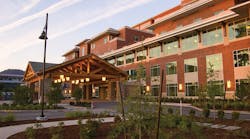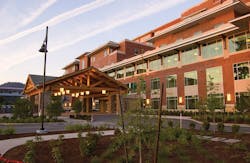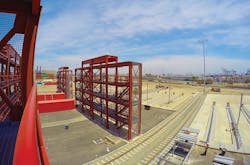Construction cranes soar above the skylines of many West Coast cities due to the swiftly growing population. With low unemployment rates and lucrative business opportunities, the West Coast is attracting many Americans like a magnet — fueling heightened activity in the electrical contracting sector.
“The West stands to be the fastest growing region of the country, and most of that growth is coming from California and Washington,” says Brian Strawberry, a research consultant for FMI Corp. in Raleigh, N.C.
Three years ago, the markets on the West Coast began rebounding, driven by an uptick in the residential, commercial, and non-residential sectors. Looking ahead, Strawberry says recent research reports indicate that the market will continue to improve in 2016 and 2017. Then they may begin to slow down, possibly due to overbuilding in select growth markets.
Related
“It will be interesting to see how it plays out,” Strawberry says. “The growth rates we are seeing in the commercial and private non-residential segments seem to be more than we would expect.”
Booming coastal markets
On the West Coast, the tech, data center, and life sciences markets are leading the growth, Strawberry says. The demand for data centers may have originated in the Silicon Valley, but it has spread to Oregon, Washington, and Colorado. Meanwhile, San Diego has a booming life sciences industry, and other commercial markets (like tourism) are also strengthening.
The growth in these key markets is creating new jobs and fueling the demand for residential and commercial projects. As such, general contractors are hiring electrical contractors to help build out mixed-use, multi-family developments with residential units, retail, and commercial services, specifically in the larger cities, he says.
For example, for the first time in San Jose and San Francisco, construction firms are building high-density residential projects. While Silicon Valley has very few high-rises, construction teams are building 15- to 20-story high-rise buildings in these cities to accommodate the influx of workers, says John Boncher, president and CEO of Cupertino Electric, headquartered in San Jose, Calif.
“Businesses are growing, and that is attracting workers, and they need housing,” Boncher says. “We are seeing a lot of mixed-used developments with underground parking, and a few towers on top of a podium.”
Ken Simonson, chief economist for the Associated General Contractors, says in San Francisco, he has noticed three trends emerge. First, tech companies are converting space in warehouses or other existing buildings into office space to attract the millennials living downtown. Meanwhile, companies like Google are transporting their employees from downtown San Francisco an hour south to the Silicon Valley on Wi-Fi-enabled luxury buses. Finally, some businesses are constructing high-rise residential and office buildings near a new subway line located close to San Francisco’s financial district.
“There is a lot going on in San Francisco, and that city is hot, hot, hot,” Simonson says.
Within Silicon Valley, the tech landscape is similar to the dot-com boom with some key exceptions, says Mike Jurewicz, COO of Sprig Electric in San Jose.
“Incredibly, the level of activity exceeds the boom period, creating more solid opportunities for electrical contracting companies,” he says. “Also, even though there are still a lot of venture capital funded projects, with a promise for producing something that will amaze us in the future, today there are large tech companies driving the venture capital impetus as well as delivering on yesterday’s promises.”
The construction scope across all trades has also expanded due to the newest Title 24 standards, enacted in July 2013. Constructing nonresidential buildings that are 30% more energy efficient adds costs and complexity as new technologies are incorporated. Electrical contracting companies are especially challenged to keep up with changes in lighting and lighting controls.
“Technology is changing so fast, a solution considered at a project’s inception can be outdated by the time the project is built,” Jurewicz says.
Sizzling in Seattle
California isn’t alone when it comes to offering opportunities for electrical contractors. Washington is right there with it. For example, within Seattle, Amazon.com and Boeing are constructing new facilities and expanding their workforce, Simonson says.
“Seattle doesn’t only have tech, but manufacturing is also a strong market,” Simonson says. “For example, Boeing has a backlog of orders with suppliers all over the place.”
Mike Douglas, vice president-construction for Electrical Construction Co., Portland, Ore., says the construction climate in Seattle has been downright crazy lately.
“It’s one of the biggest construction markets in the history of Seattle, including during the construction boom of the 1960s and again in the 1980s when Boeing was going really strong and Microsoft was growing,” says Douglas, whose firm is one of EC&M’s Top 50 players and has offices in Portland, Ore.; Seattle; and northern California. “The last time I was up there, I counted more than 35 tower cranes in downtown Seattle.”
One market that is hot in Seattle, as well as neighboring regions, is data center work, says Roy Hella, vice president of Electrical Construction Co.’s Seattle office. The three predominant spots for data center construction are eastern Oregon, eastern Washington, and northern California, Hella says. These three areas share two significant commonalities — they are located near dams so they can leverage cheap hydroelectric power, which hovers at around 2.3 cents a kW hour; and the land is inexpensive.
“We speculate that for the next three to five years, data centers will continue to be strong in these areas,” Hella says. “Data centers have a huge power draw, and they are not manned, so they don’t require a lot of resources to keep them operating.”
Predominately, the data centers are digital information colocation facilities, and they range in size from 5MW to 50MW. Over the next five years, Electrical Construction Co. projects that the value of data center work will hover close to $5 billion, which includes the cost of owner-furnished equipment and electrical and construction services.
On the West Coast, other significant markets revolve around infrastructure such as highways, bridges, dams, utilities, and roads due to the need for replacement and government’s approval of investment. Another market that’s gaining traction in the Northwest is the health care market.
“Health care is huge out here,” Douglas says. “We are seeing several billions of dollars of health care work either in the planning or construction phase, with some projects topping $500 million per facility. There are large research and development facilities under construction, and money is being spent on new patient care facilities and retrofitting and upgrading existing health care centers.”
A combination of general facility wear-and-tear, an aging population, and technological advancements in medicine drive the growth in the health care market in the Northwest, he says.
“We haven’t had a boom in health care since the 2000s, and it’s time for a release of money into this market,” Douglas says. “It seems that every 20 years, a market segment will undergo a significant investment period, and there have been a lot of advancements in technology with imaging equipment, alternative medicine, early detection, and preventive health care. To support these advancements, you can’t just put that new equipment in an unused office area. Instead, you must have a dedicated area with the required power, infrastructure, and room size to utilize it.”
In addition, Douglas says he’s seeing a number of teaching facilities under construction that support health sciences facilities. For example, in Portland, Ore., one of the largest research and training facilities for dentists on the West Coast just opened two years ago. Electrical Construction Co. also has one of its biggest high-tech clients right in its backyard — Intel, which has its research and development facilities in Portland.
“They are dedicated to doing all their research and development work out here, and, according to a local newspaper, they have committed to invest $100 billion over the next 30 years in their Hillsboro facility,” he says.
Within the education market, the Portland and Seattle school districts each have a number of bonds, which are valued at nearly $3 billion for each metro area. Specifically, the bond measures are targeted for the construction of new schools for the increasing regional population, upgrading aging schools with substantial facility additions and remodel work that include replacing or upgrading infrastructure systems such as inefficient boilers with central utility plants and swapping incandescent lighting with LED technology. While the state of Oregon does not need to comply with the same stringent Title 24 energy efficiency standards as California, state-funded schools have incentives to incorporate green features into their projects.
“Oregon has incentive programs available from a range of sources, and facility owners have state and national funds available to support their construction activities if they can comply,” he says.
Staffing woes
With both the commercial and industrial markets going strong in Portland and Seattle, it is challenging to find qualified management staff and field labor, Douglas says.
Electrical Construction Co. is preparing for one of the biggest construction years in the history of Portland. So far, Douglas says his firm is able to still access enough labor to staff the work. The company has a full-time equivalent staff of about 800, but it can expand or contract, depending upon market conditions. The company’s work spans 25 or 30 locals, and, when possible, tries to draw out of locals closest to the job sites. Meanwhile, in the Bay Area, the union contractors have access to a vast workforce.
“The Bay Area is kind of unique,” Jurewicz says. “We have nine locals within a 50-mile radius of San Jose, but the three busiest locals are Santa Clara, San Mateo, and San Francisco counties. The surrounding areas are not as active, and housing costs are lower so a lot of people are commuting, even from the Central California Valleys. Drawn by abundant work and higher wages, Central Valley contractors are challenged to keep local workers working locally.”
Boncher has also noticed that while some areas are going like gangbusters, other spots are relatively slow.
“There are areas that are so white hot that it is mind boggling,” Boncher says. “Then you can drive 15 miles into another region, which is still within the same business landscape, and there is nothing going on.”
Throughout the West Coast, however, electrical contracting companies are embracing opportunities as the construction market continues to heat up. While many contractors are constrained by the lack of skilled labor and rapidly changing technology, firms are riding the wave of prosperity and meeting the demand in growing cities up and down the coast.
Fischbach is a freelance writer based in Overland Park, Kan. She can be reached at [email protected].
SIDEBAR: West Coast Trends by the Numbers
In a recent report, titled “Western Economic Update,” Wells Fargo Securities released data on the population, labor market, and non-residential construction trends in seven major cities on the Pacific coast — San Francisco, Riverside, Los Angeles-Oakland, and San Diego, Calif.; Portland, Ore.; and Seattle-Tacoma, Wash. Here are some fast facts from the report.
• San Francisco and San Jose tied with the lowest unemployment rates of the seven
cities with 4.5%. Los Angeles had the highest rate at 7%.
• Los Angeles has the highest population of the seven cities with about 13.263 million,
while San Jose had the least residents with 1.953 million.
• Seattle had the highest annual average population growth rate of 1.7% between 2010
and 2014, with Los Angeles having the lowest at 0.9% over the same four-year period.
• The volume of non-residential construction starts in 2014 was the highest in
San Francisco and Seattle. In addition, the percentage change of starts from 2014
to 2013 in these two cities was also the highest at more than 34%.






